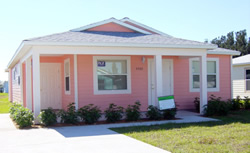
|
|
August 2007 |
Is Everyone Seeing Green?
The word “green” no longer just describes a color but has come to represent an energy efficient way of life. Apparently the times are a changin’ – more and more people are making their homes green and now the first green-certified Habitat for Humanity (HFH) home in the state is in Indian River County. Indian River County HFH built the house, sponsored by WCI – a leading builder of communities in Florida, with green certification as a requirement. It was a success according to Jennifer Languell, vice president of the Florida Green Building Coalition (FGBC), which officially certified the house under the FGBC Green Home program. Now Indian River County HFH is considering which green features they will adopt as standard practice. Languell, speaking to TC Palm News said, “This just shows that affordable housing can be green. That’s a contrast from the usual impression that pro-environment modifications are reserved for high-end housing.”
Green certification is awarded to a house that meets standards set by the FGBC, which uses a point-based system with eight categories to evaluate the site, design, and specifications of a house. Preserving trees around the home, installing ENERGY STAR® appliances such as dishwashers, clothes washers and dryers, refrigerators and ovens; utilizing compact fluorescent light bulbs; employing low water use and providing for excellent indoor air quality are just some of the ways to make a house green. When it comes to building energy-efficient homes, most people tend to think that it’s expensive, but believe it or not, it’s just the opposite – and certification of the Indian River house is proof. Additionally, part of green certification is conducting an energy evaluation called a Home Energy Rating. The Florida Solar Energy Center (FSEC) produced the Home Energy Rating, also called an ENERGY STAR rating, for this home, as they have done for many Habitat affiliates around the country. The ENERGY STAR Homes program recognizes homes that use 15 percent less energy than those built to the International Energy Conservation Code. Habitat for Humanity International has adopted ENERGY STAR as a construction best practice, and 50 HFH affiliates have built more than 2,500 ENERGY STAR homes across the country. Indian River County is not the only area in Florida where Habitat is building green homes. Since 2000, Lakeland HFH, under the leadership of Executive Director Claire Twomey, has been building homes that exceed ENERGY STAR standards, saving an estimated additional 5 to 15 percent in whole house energy use. Fifty-one homes have been built and six more are planned for this year. According to Twomey, installing items in the home such as a radiant barrier, low E-windows and interior ducts saves energy, a major component of green building. Energy efficiency can be incorporated even in affordable housing built by volunteers, as Habitat for Humanity has proven. “We reviewed the utility bills for our first house for five years and compared it to a house with the same square footage and same family size that was built six months earlier without the energy-efficiency changes. Utility savings were 60 percent,” says Twomey. “Some of our homeowners are coming from rental homes where they were paying $400 or $500 per month in utility bills,” she adds. Purchasing an energy-efficient home that saves in operating expenses is a big perk. In addition to energy efficiency, Lakeland Habitat homes feature an outside air ventilation system that provides a slight positive pressure in the house, eliminating infiltration of hot, humid air in the air conditioning system. This improves energy efficiency as well as comfort and indoor air quality. Installing a radiant barrier on the underside of the roof decking can greatly reduce the heat gain in the house, thereby conserving energy to cool the house. And this is important since air conditioners make up about 40 percent of home energy use in Florida’s hot humid climate. “FSEC research has shown that roof-mounted radiant barriers can reduce ceiling heat flux by 25 to 50 percent with annual cooling electricity savings of 7 to 10 percent,” says Janet McIlvaine, FSEC liaison to HFH. For Lakeland Habitat, it’s about quality and that is why each home is inspected and tested before being sold. With the help of FSEC, through the Department of Energy’s Building America Program, testing is used as a checkpoint to make sure the houses are being built to specification and energy-efficient items are being installed correctly. Just by looking at the house one would not be able to tell if there is duct leakage or unsealed joints behind the drywall that allow outside air to infiltrate. McIlvaine says, “Testing is a quality assurance procedure and the only way to determine actual air tightness since a visual inspection can miss small holes.” Twomey adds, “It’s very rewarding to the volunteers and construction staff when the house scores high and they know they’ve done it right.” Although there is more emphasis on incorporating energy efficient and green features in building a new home, these features can be added to an existing home too. “Take small steps and build on your success. One of the easiest things to do is to replace incandescent light bulbs with compact fluorescent light bulbs (CFL) as they burn out. Small investments like this pay off in monthly savings. In the case of CFLs, they also last five to ten times as long as incandescent bulbs, which makes them ideal for hard to reach fixtures - an added benefit,” says McIlvaine. FSEC advocates energy efficient homes and has done so for over three decades by producing research and a wealth of practical information that builders and homeowners can access online at www.fsec.ucf.edu/en/consumer. McIlvaine says, “The Indian River County Habitat and Lakeland Habitat homes are great examples of success and we hope they will be a catalyst for change in their communities.” Additional Information For an in-depth look at FSEC’s work with Lakeland Habitat, take a look at the case study on FSEC’s Building America - Habitat for Humanity partnership Web page: www.baihp.org/habitat/. The Florida Green Building Coalition’s green certification checklist. The Florida Green Building Coalition Web site: www.floridagreenbuilding.org |

